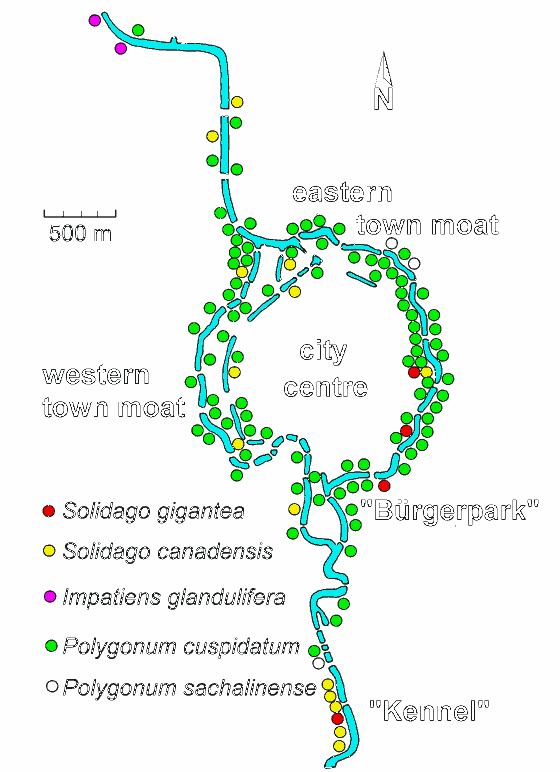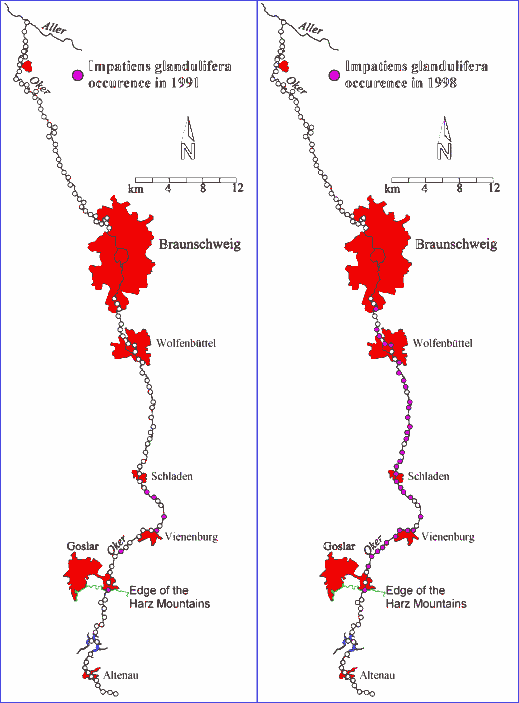Alien plants
Most of the frequent alien species of the Oker system are escaped ornamental
plants. The input of these species or their diaspores comes from adjacent
gardens. This influence becomes clearly visible by the alien flora along
the town moats of Braunschweig too. With the exception of Bidens frondosa
most alien species of annual ruderal vegetation, which are common along
the Weser or Elbe riverbanks, are missing at the smaller Oker.
Most frequent alien species of the Oker system
|
River:
|
Oker
|
Radau
|
Ecker
|
Ilse
|
Altenau
|
Wabe
|
Schunter
|
|
Number of sampling sites:
|
107
|
19
|
18
|
41
|
12
|
28
|
59
|
| Bidens frondosa |
61%
|
0%
|
17%
|
5%
|
0%
|
0%
|
8%
|
| Epilobium ciliatum |
63%
|
47%
|
28%
|
17%
|
8%
|
32%
|
20%
|
| Polygonum cuspidatum |
13%
|
63%
|
17%
|
15%
|
0%
|
0%
|
0%
|
| Impatiens parviflora |
7%
|
47%
|
61%
|
46%
|
17%
|
21%
|
10%
|
| Galanthus nivalis |
0%
|
58%
|
6%
|
0%
|
0%
|
4%
|
2%
|
| Impatiens glandulifera |
7%
|
47%
|
0%
|
20%
|
0%
|
0%
|
0%
|
| Armoracia rusticana |
2%
|
0%
|
0%
|
10%
|
42%
|
18%
|
22%
|
| Geranium pyrenaicum |
0%
|
5%
|
0%
|
32%
|
0%
|
7%
|
12%
|
| Veronica persica |
0%
|
0%
|
0%
|
10%
|
8%
|
21%
|
19%
|
| Solidago gigantea |
21%
|
21%
|
11%
|
0%
|
0%
|
14%
|
12%
|
| Conyza canadensis |
10%
|
5%
|
11%
|
20%
|
0%
|
11%
|
19%
|
| Heracleum mantegazzianum |
10%
|
21%
|
11%
|
0%
|
0%
|
7%
|
2%
|
| Polygonum sachalinense |
0%
|
21%
|
0%
|
2%
|
0%
|
0%
|
0%
|
| Matricaria discoidea |
3%
|
5%
|
6%
|
20%
|
8%
|
11%
|
15%
|
| Galinsoga ciliata |
0%
|
11%
|
0%
|
20%
|
0%
|
0%
|
3%
|
|
Dispersion of alien plants along the town moats
of Braunschweig
|
 |
| (changed after GROTHE & BRANDES 1991) |
Only few occurrence of Impatiens glandulifera were recorded by
extensive investigations of the Oker river in 1991. Between Schladen and
Braunschweig the whole Oker was examined by boat and no occurrence of this
species was noticed. Since 1994 Impatiens glandulifera shows a remarkable
spreading along the Oker river. In 1998 the same sampling sites as 1991
were examined between Braunschweig and the Harz Mountains in connection
with occurrence of Impatiens glandulifera. The extent of the spreading
is shown in following maps.



